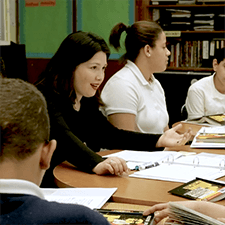Please share your experience with SERP.
for STARI classes unable to meet in person.

Strategic Adolescent Reading Intervention (STARI)
STARI is a literature-focused, Tier II intervention for students in grades 6-9 who read two or more years below grade level.
By the time students reach the middle grades, they are expected to read to learn instead of to learn to read. But for the significant number of students who can’t decode or fluently read more complex text, this shift spells trouble. In addition, older students (Grades 6-9) who need targeted, intensive reading instruction are still adolescent thinkers! They do not find typical remedial materials engaging.
STARI is built around key research findings:
- Adolescent struggling readers need to work on both basic reading skills and the skills that underlie deep comprehension: academic language, perspective-taking, and critical reading.
- Texts need to engage students with issues in their lives and in the world.
- Peer talk about text can develop reading engagement, perspective-taking, and critical reading.
Using research-based practices and highly engaging texts, STARI addresses gaps in fluency, decoding, reading stamina, and comprehension, aiming to move struggling students to higher levels of proficiency at the end of one year. STARI actively engages students in discussions of cognitively challenging content aligned to the Common Core and other 21st century standards.
STARI is intended to be a “double dose” intervention that should not take the place of core curriculum. We recommend that schools devote either 45-60 minutes, 5 days a week, or 90 minutes on an A-day/B-day schedule, to STARI.

STARI has helped me become a better reader because talking with others and hearing the opinions of others can help me learn more about what I'm reading about.
Jasmine, 7th Grade Student

STARI has actually helped me to become a better reader because, at the beginning of the year, I thought I wasn't much of a fluent reader. I kept pausing in the middle of reading a sentence. But the more I read, the more practice it took ... I just became better.
AJ, 8th Grade Student

In some of the other intervention programs that I've taught there's really an emphasis on one component of language, so the emphasis might just be on fluency or might just be on decoding or just on comprehension.
STARI gives me the opportunity to reach across to where a lot of the gaps are. In my student group, you have English language learners, students with IEPs, and students who have just been low-performing or plateauing in their reading skills.
I think that having that holistic approach to developing reading skills, including the discussion components, really makes a big difference.
Ariadna Phillips-Santos, 8th Grade Teacher
Hear from more STARI teachers and students:
-
Why is a program like this necessary?
Middle school students who are several years behind in reading face enormous academic challenges. They can’t understand their subject area texts and have difficulty keeping up with class assignments. As the gap increases between their current reading skills and the literacy demands of content instruction, many fail key subjects. STARI is designed to close the comprehension gap between struggling readers and their on-level peers. STARI also aims to build reading confidence, stamina, and engagement, along with classroom discussion skills that are critical for success in secondary school and beyond.
-
What’s different about teaching adolescents to read?
Unlike younger students who can hone their reading skills with familiar content, adolescents are already immersed in more demanding contexts of literacy use. Middle school teachers appropriately expect that students will use literacy to acquire new information and reflect critically about what they read. By sixth grade, students are exposed to a wide range of genres beside simple narratives: historical exposition, scientific description, multiple forms of poetry and prose. A program for struggling adolescent readers needs to simultaneously address “basic” aspects of literacy: accurate decoding, fluent oral reading, literal comprehension, and the critical and disciplinary reading skills expected of older readers. Because struggling older readers have experienced years of underachievement, effective intervention also needs to address reading motivation, confidence, and engagement.
-
How is STARI different from other reading interventions?
Adolescent reading interventions have often shown only modest gains, especially for those students who are furthest behind in reading (Somers et al., 2010; Vaughn, Cirino, Wanzek et al., 2010). Interventions that primarily target basic skills may not improve adolescents’ performance with more challenging literacy tasks such as finding text-based evidence for a claim or integrating information across different texts.
STARI addresses reading motivation and engagement through high-interest novels and nonfiction that challenge students to think more deeply about issues in their lives. In STARI, attention to basic skills is integrated with activities involving talking, reasoning, and writing about complex issues. STARI’s classroom formats, including many opportunities for peer exchanges, tap into adolescents’ social motivations to talk about ideas they care about.
STARI is also different from many reading interventions in that discussion and debate are fundamental to the curriculum. Our belief is that when students discuss and debate the ideas in the text, they understand the text more deeply. Discussion and debate are built into most components of the curriculum, from partners discussing fluency passages to more formal debates about unit themes. Additionally, STARI is an ELA focused curriculum in which skills practice is integrated into comprehension activities. Also, the different components connect with one another in a purposeful way. For example, the fluency practice passages build background knowledge and provide information that can be used to better understand and give context to other texts in each unit.
Capti Assess with ETS ReadBasix is a 45-60-minute web-based assessment appropriate for diagnosing the reading skills of students in grades 3 through 12. This assessment (formerly the RISE) was developed to help identify students who struggle with basic reading skills and provide detailed information to teachers about the nature of their struggles.
Development of STARI was led by Lowry Hemphill (Wheelock College) through a SERP collaboration with Harvard University and four Massachusetts school districts. The research reported here was supported by the Institute of Education Sciences, U.S. Department of Education, through Grant R305F100026 to the Strategic Education Research Partnership as part of the Reading for Understanding Research Initiative. The opinions expressed are those of the authors and do not represent views of the Institute or the U.S. Department of Education.
The STARI Team
Strategic Education Research Partnership
SERP Institute
1100 Connecticut Ave NW
Suite 1310
Washington, DC 20036
SERP Studio
2744 East 11th Street
Oakland, CA 94601
(202) 223-8555
Registered 501(c)(3). EIN: 30-0231116
